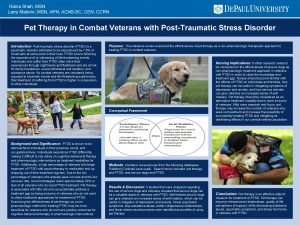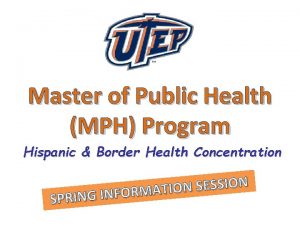Jennifer Leonard MSN MPH Larry J Maturin MSN

- Slides: 1

Jennifer Leonard, MSN, MPH Larry J. Maturin, MSN, APN, ACNS-BC, CEN, CCRN Advance Directives Should Be Part of Admission Process for Adults with Cancer Introduction: The National Institute of Cancer estimates that Nursing Implications: Nurses, specifically oncology approximately 40 percent of individuals will be diagnosed with cancer during their lifetime, and of those 171. 2 per 100, 000 will result in death every year. A cancer diagnosis generates questions regarding end-of-life care. Advanced Care Planning (ACP) should initiate a conversation between the patient, health care providers, and family members regarding health care and treatment preferences for the patient. These preferences can and should be documented in an Advance Directive (AD) allowing the patient to have more control over medical treatment decisions in accordance with their goals and values. nurses, should be prepared to enter into discussions with patients to help them clarify their values, beliefs, and understanding of themselves in the context of their diagnosis. The nurse plays an integral role of ensuring that AD are communicated effectively to members of the health care team. Based on the unique relationship nurses have with patients and family members it is imperative that nurses are guided by The Code of Ethics ensuring patients’ choices and dignity. Purpose: First to perform an integrative literature review to determine the current standards for implementation of advance directives for adults with a cancer diagnosis. Second, to investigate the rationale for patients not having an AD on file after a cancer diagnosis. Lastly, to demonstrate the need and practical reason for standardizing the implementation of advance directives for cancer patients on admission to an oncology service. Methods: Literature reviewed was from the following databases: Pub. Med, CINAHL, Up To Date, Google Scholar, and National Cancer Institute. Search terms included: advance directives, adult, and terminal oncology. Conceptual Framework Results & Discussion: An AD is the legal document Weick’s Model ensuring patient autonomy during end-of-life. With less than 50 % of individuals admitted to an oncology unit having an AD, the process needs to change. Conclusion: Advance Directives along with health Reference: Dow, L. A. , Matsuyaman, R. K. , Ramakrishnan, V. , Kuhn, L. , Lamont, E. B. , Lyckholm, L, Smith, T. J. (2010). Paradoxes in advance care planning: the complex relationship of oncology patients, their physicians, and advance medical directives. Journal of Clinical Oncology, 28, 299 - 304. doi: 10. 1200/JCO. 2009. 24. 6397; Gross, M. D. (1998). What Do Patients Express as Their Preferences in Advanced Directives? Archieves Internal Medicine, 158, 363 - 365. ; Garrido, M. M. , Balboni, T. A. , Maciejewski, P. K. , Bao, Y. , Prigerson, H. G. (2015). Quality of Life and Cost of Care at the End of Life: The Role of Advanced Directives. Journal of Pain Symptom Management, 49, 828 -835. doi: 10. 1016/j. jpainsymman. 2014. 09. 015; Saraiya, B. , Bodnar-Deren, S. , Leventhalk, E. , Leventhal, H. (2008). End of life planning and its relevance for patients and oncologists’ decisions in choosing cancer therapy. Cancer, 15, 3540 -3547. doi: 10. 1002/cncr. 23946 care provider communication and adherence to AD can reduce end of life cost and maintain quality of care and life for patients. Initiating an AD should be part of the admission process for adult oncology patients.

